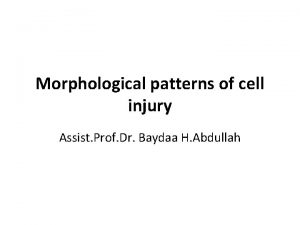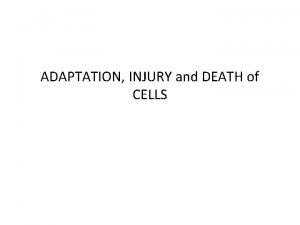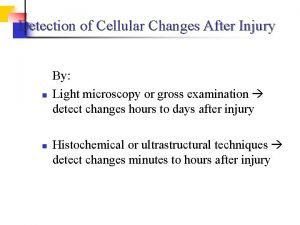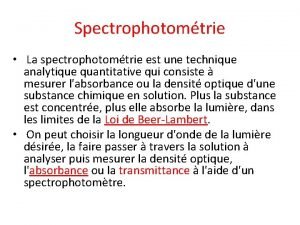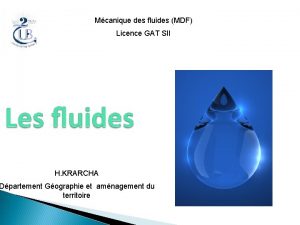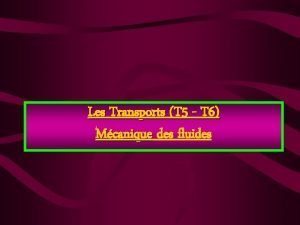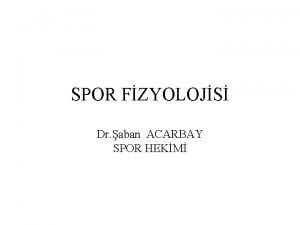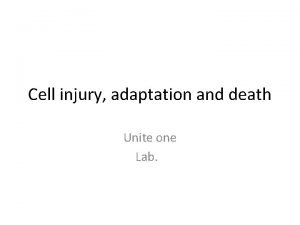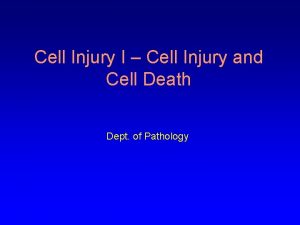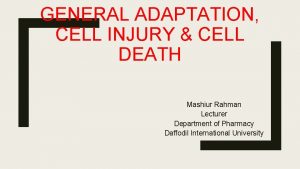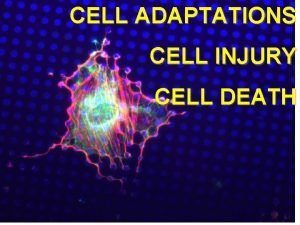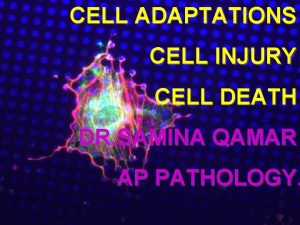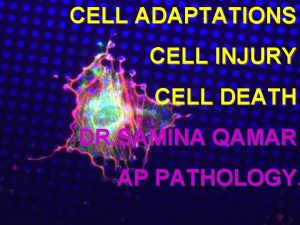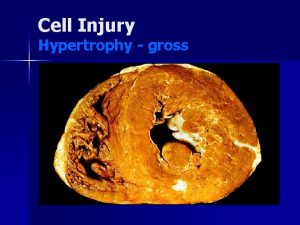Cell injury adaptation and death Unite one Second

































- Slides: 33

Cell injury, adaptation and death Unite one Second Lab.

The two lung abscesses seen here are examples of liquefactive necrosis in which there is a liquid center in an area of tissue injury. One abscess appears in the upper lobe and one in the lower lobe. Liquefactive necrosis is typical of organs in which the tissues have a lot of lipid (such as brain) or when there is an abscess with lots of acute inflammatory cells whose release of proteolytic enzymes destroys the surrounding tissues.

The liver shows a small abscess here filled with many neutrophils. This abscess is an example of localized liquefactive necrosis.

Grossly, the cerebral infarction at the upper left here demonstrates liquefactive necrosis. Eventually, the removal of the dead tissue leaves behind a cavity. As this infarct in the brain is organizing and being resolved, the liquefactive necrosis leads to resolution with cystic spaces.

This is liquefactive necrosis in the brain in a patient who suffered a "stroke" with focal loss of blood supply to a portion of cerebrum. This type of infarction is marked by loss of neurons and neuroglial cells and the formation of a clear space at the center left.

At high magnification, liquefactive necrosis of the brain demonstrates many macrophages at the right which are cleaning up the necrotic cellular debris. The job description of a macrophage includes janitorial services such as this, particularly when there is lipid.

This is fat necrosis of the pancreas. Cellular injury to the pancreatic acini leads to release of powerful enzymes which damage fat by the production of soaps, and these appear grossly as the soft, chalky white areas seen here on the cut surfaces.

Microscopically, fat necrosis adjacent to pancreas is seen here. There are some remaining steatocytes at the left which are not necrotic. The necrotic fat cells at the right have vague cellular outlines, have lost their peripheral nuclei, and their cytoplasm has become a pink amorphous mass of necrotic material.

This is the gross appearance of caseous necrosis in a hilar lymph node infected with tuberculosis. The node has a cheesy tan to white appearance. Caseous necrosis is really just a combination of coagulative and liquefactive necrosis that is most characteristic of granulomatous inflammation.

This is more extensive caseous necrosis, with confluent cheesy tan granulomas in the upper portion of this lung in a patient with tuberculosis. The tissue destruction is so extensive that there areas of cavitation (cystic spaces) being formed as the necrotic (mainly liquefied) debris drains out via the bronchi.

Microscopically, caseous necrosis is characterized by a cellular pink areas of necrosis, as seen here at the upper right, surrounded by a granulomatous inflammatory process.

This is gangrene, or necrosis of many tissues in a body part. In this case, the toes were involved in a frostbite injury. This is an example of "dry" gangrene in which there is mainly coagulative necrosis from the anoxic injury.

This is gangrene of the lower extremity. In this case the term "wet" gangrene is more applicable because of the liquefactive component from superimposed infection in addition to the coagulative necrosis from loss of blood supply. This patient had diabetes mellitus.

Gangrenous necrosis involves the tissues of a body part. The inflammation seen here is extending beneath the skin of a toe to involve soft tissue (fat and connective tissue) and bone. Because multiple tissues are non-viable, amputation of such areas is necessary.

Cytoplasmic organelle damage leads to a variety of injury patterns, most of which are best seen by electron microscopy. Acute injuries tend to damage an entire cell, so specific organelle damage is beside the point. However, in some cases the damage can be cumulative over many years. Here are Mallory bodies (the red globular material) composed of cytoskeletal filaments in liver cells chronically damaged from alcoholism. These are a type of "intermediate" filament between the size of actin (thin) and myosin (thick).

Here are neurofibrillary tangles in neurons of a patient with Alzheimer's disease. The cytoskeletal filaments are grouped together in the elongated pink tangles.

Intracellular accumulations of a variety of materials can occur in response to cellular injury. Here is fatty metamorphosis (fatty change) of the liver in which deranged lipoprotein transport from injury (most often alcoholism) leads to accumulation of lipid in the cytoplasm of hepatocytes.

The liver injury with chronic alcoholism leads to fibrosis and regeneration of the hepatocytes in nodules. This firm, nodular appearance of the liver as seen here is called cirrhosis.

This Congo red stain reveals orange-red deposits of amyloid, which is an abnormal accumulation of breakdown products of proteinaceous material that can collect within cells and tissues.

Sometimes cellular injury can lead to accumulation of a specific product. Here, the red globules seen in this PAS stained section of liver are accumulations of alpha-1 -antitrypsin in a patient with a congenital defect involving cellular metabolism and release of this substance.

Many inherited disorders of metabolism involving enzymes in degradation pathways can lead to accumulation of storage products in cells, as seen here with Gaucher disease involving spleen. The large pale cells contain an accumulated storage product from lack of the glucocerebrosidase enzyme.

The yellow-brown granular pigment seen in the hepatocytes here is lipochrome (lipofuscin) which accumulates over time in cells (particularly liver and heart) as a result of "wear and tear" with aging. It is of no major consequence, but illustrates the end result of the process of autophagocytosis in which intracellular debris is sequestered and turned into these residual bodies of lipochrome within the cell cytoplasm.

The brown coarsely granular material in macrophages in this alveolus is hemosiderin that has accumulated as a result of the breakdown of RBC's and release of the iron in heme. The macrophages clear up this debris, which is eventually recycled.

A Prussian blue reaction is seen in this iron stain of the liver to demonstrate large amounts of hemosiderin that are present within the cytoplasm of the hepatocytes and Kupffer cells. Ordinarily, only a small amount of hemosiderin would be present in the fixed macrophage-like cells in liver, the Kupffer cells, as part of iron recycling.

These renal tubules contain large amounts of hemosiderin, as demonstrated by the Prussian blue iron stain. This patient had chronic hematuria.

The sclera of the eye is yellow because the patient has jaundice, or icterus. The normally white sclerae of the eyes is a good place on physical examination to look for icterus.

The yellow-green globular material seen in small bile ductules in the liver here is bilirubin pigment. This is hepatic cholestasis.

Increased amounts of circulating bilirubin in the blood can lead to the physical examination finding of "icterus" or jaundice as seen here from the yellowish hue of the skin. The easiest place to see icterus is on the sclera of the eye.

The black streaks seen between lobules of lung beneath the pleural surface are due to accumulation of anthracotic pigment. This anthracosis of the lung is not harmful and comes from the carbonaceous material breathed in from dirty air typical of industrialized regions of the planet. Persons who smoke would have even more of this pigment.

Here is anthracotic pigment in macrophages in a hilar lymph node. Anthracosis is nothing more than accumulation of carbon pigment from breathing dirty air. Smokers have the most pronounced anthracosis. The anthracotic pigment looks bad, but it causes no major organ dysfunction.

This is dystrophic calcification in the wall of the stomach. At the far left is an artery with calcification in its wall. There also irregular bluish-purple deposits of calcium in the submucosa. Calcium is more likely to be deposited in tissues that are damaged.

Here is so-called "metastatic calcification" in the lung of a patient with a very high serum calcium level (hypercalcemia).

The next Lab. Is Inflammation
 Examples of intentional injury
Examples of intentional injury Cell injury and inflammation
Cell injury and inflammation Dry gangrene vs wet gangrene
Dry gangrene vs wet gangrene Mucoid change in cell injury
Mucoid change in cell injury Genetic causes of cell injury
Genetic causes of cell injury Cell injury
Cell injury Myelin figures in reversible cell injury
Myelin figures in reversible cell injury Example of physiological hyperplasia
Example of physiological hyperplasia Reversible cell injury
Reversible cell injury Difference between somatic and cellular death
Difference between somatic and cellular death Night structure
Night structure 27 miles per gallon into kilometers per liter
27 miles per gallon into kilometers per liter One god one empire one emperor
One god one empire one emperor One one one little puppy run
One one one little puppy run One king one law one faith
One king one law one faith Byzantine definition
Byzantine definition One ford behaviors
One ford behaviors See one do one teach one
See one do one teach one One price policy
One price policy Studiendekanat uni bonn
Studiendekanat uni bonn Asean tourism strategic plan
Asean tourism strategic plan One vision one identity one community
One vision one identity one community Unité didactique d'apprentissage
Unité didactique d'apprentissage Loi beer lambert
Loi beer lambert La viscosité dynamique
La viscosité dynamique Les transports t
Les transports t Doz hesaplama soruları
Doz hesaplama soruları Unite words
Unite words Loi de beer-lambert
Loi de beer-lambert Ascom unite assign
Ascom unite assign Unité de mesure du volume
Unité de mesure du volume öğrenme psikolojisi bellek türleri
öğrenme psikolojisi bellek türleri Yavaş oksidatif lifler
Yavaş oksidatif lifler Kasların ortak özellikleri
Kasların ortak özellikleri


